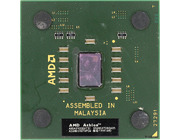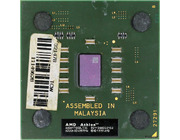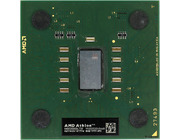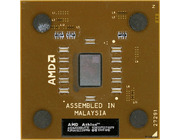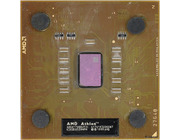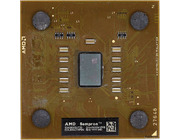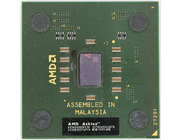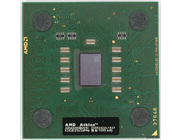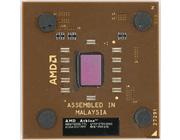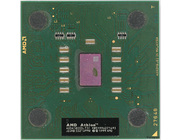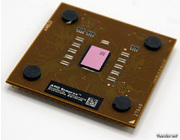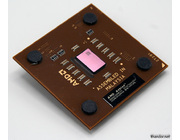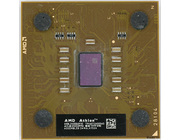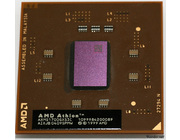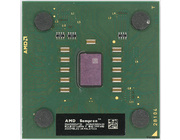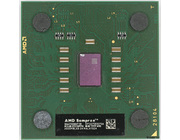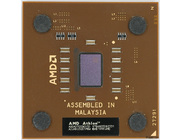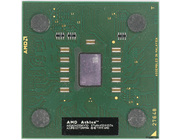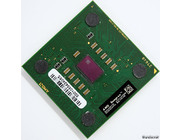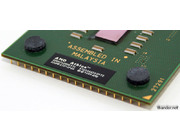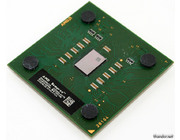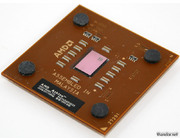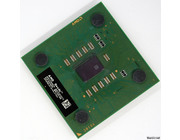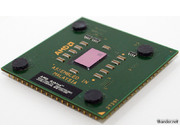Released in August 2002 as successor to the Thoroughbred 'A'. It was still 130nm but refined and optimized to reach higher clock-frequencies. AMD added a 9th layer ('A' had 8 layers) to improve electrical conduction between parts of the CPU. This greatly increased stability at higher clocks.
In early 2003 AMD perfected the 130nm production process. AMD had good yields per wafer that caused AMD to sell high-quality chips rated at low speeds to satisfy demands on budget CPU's. It didn't take long for people to find out that the cheap 1700+ and 1800+ CPU's could reach clock-frequencies equal or exceeding those of AMD's high-end CPU's. Back in the day I bought a 60 Euro XP1700+ that ran at 2,5GHz for years with ease. Some even exceeded 3GHz using LN2 (Hydrogen) cooling!
The Thoroughbred 'B' got AMD back on the track after the Palomino (180nm) was stretched to it's limits and Thoroughbred 'A' didn't meet expectations.
Personally I loved this chip in combination with the nForce2 chipset. Easy to overclock, dead stable and by setting latencies right (and tight using proper memory chips), the feeling of the system was really snappy. And, of course the excellent price/performance ratio.
A less common Athlon XP CPU. By the time people were buying faster models the Athlon XP 'Barton' was mainstream. The 'Barton' features 512KB L2-cache whereas the 'Thoroughbred' has 256KB L2-cache. > Read more
The Athlon XP 2600+ came in three versions and in my opinion this is the best one.
XP2600+ running at 2083MHz with 166MHz (DDR333) FSB and 256KB L2-cache.
XP2600+ running at 2133MHz with 133MHz (DDR266) FSB and 256KB L2-cache.
XP2600+ running at 1917MHz with 166MHz (DDR333) FSB and 512KB L2-cache.
This version runs at 2083MHz and uses the quicker 166MHz (DDR333) front-side-bus. AMD also released a version for the slower 133MHz (DDR266) front-side-bus, but this CPU lacks bus throughput. The third version is based on the 'Barton'-core and features 512KB L2-cache. It has a slower clockfrequency which affects performance and the extra 512KB L2-cache is not able to compensate this. > Read more
Just like this Sempron 2200+ but one multiplier, in this case 1x166MHz, faster.
The Sempron was marketed as budget CPU: something this CPU really is, too. In 2004 there were CPU's available that are much faster. > Read more
The second fastest 133MHz (DDR266) FSB-based CPU for socket 462. The fastest is the 2600+ (on DDR266) but it's quite rare and not the best choice of CPU out there. The 2400+ is doing quite well, though.
AMD uses a rating system for their Athlon XP processors. Back in the old days an Athlon XP 1500+ would be as fast as an Athlon (Thunderbird) at 1500MHz. In practical situations this was true but eventually it depends on which application you use. As the Athlon XP got faster the given rating went up with 100+ for each 66MHz it got faster. For games this rating system works quite well untill somewhere around the 2200+ or 2400+. If you use the regular 2600+ (DDR333 FSB) with the Thoroughbred core it will give you a huge jump ahead on the 2400+ despite the rating difference is only 200+. This is because the front side bus is increased to 166MHz (DDR333) which will speed up the whole system. The 2600+ with 133MHz (DDR266) FSB doesn't have this 'extra' and won't be that much faster than the 2400+.
In practical terms a CPU needs a front side bus that sort of suits the CPU. Once I tested an Athlon XP at 2533MHz (real clock frequency) with a 133MHz (DDR266) FSB. A ridiculous FSB ~ clock ratio combination which was clearly visible in performance because the 2533/133 combination was actually slower in several cases than an Athlon XP 2600+ with 2083MHz and a 166MHz (DDR333) FSB! > Read more
Successor of the Duron and technically this is just an Athlon XP Thoroughbred but at a lower clock frequency. To compensate speed loss for the lower clock frequency the front side bus is cranked up a bit. Instead of DDR266 it's DDR333 (166MHz) now. AMD was able to do this without problems because all, even the budget, motherboards could run this FSB in 2004.
This CPU was made in the 48th week of 2004 and can be considered a real budget CPU. It's not speedy at all and in the 3rd quarter of 2004 CPU's like the Athlon64 3800+ were more than twice as fast. > Read more
An overclocking genuis! This CPU once booted (highly unstable, though) at 2300MHz with only 1,5V and did 2,7GHz using watercooling. My other Athlon XP 'Thoroughbred' CPU's didn't achieve this so easily. Only my Duron 1800 did 2,7GHz as well but doesn't have an unlocked multiplier.
I bought this CPU in February 2005 and because it overclocked better than the 1700+ I had I used this CPU for a while until I switched over to a dual-core CPU. After upgrading this Athlon XP 1800+ ran for a few years in my home-server (24/7) at 2GHz, with air-cooling and a low core voltage to preserve energy. Eventually it got replaced by an Athlon64 3200+ system that uses almost the same energy but runs a bit faster. The Athlon64 was installed because it had a Zalman CNPS7000B-Cu (copper) cooler that allows it to run passive when idle. The Athlon XP could not run with the Zalman cooler because the heatsink didn't fit on the motherboard.
> Read more
The name Geode was launched by National Semiconductor in 1999. That chip was derived from Cyrix' MediaGX. AMD bought the Geode in 2003 and continued with the Geode GX, LX and NX. The first two are Cyrix-designs and the latter is an Athlon XP.
This Geode NX 1750 uses a Thoroughbred core like many desktop and mobile Athlon XP's did. The cores on the Geode NX run with a lower core voltage, however. Because the Geode NX has one of the finer chips in quality they usually overclock quite good. This CPU does it's job quite well but not as good as my trusty (and darn good) Athlon XP 1800+ 'Thoroughbred' which is about 2,5 years older.
To use the Geode NX you need a suitable motherboard. I ran it on the SiS745-based ECS K7S6A. In case you want to run a Geode NX be sure to Google for compatible motherboards. It's most likely you have to use a SiS or VIA chipset. nForce2 tends to be more difficult. > Read more
My first AMD Athlon XP! I bought it along with an EPoX 8RDA and one 512MB DDR333 RAM module back in May 2003. Back then it wasn't the fastest setup money could buy but I selected the hardware for overclocking. The Athlon XP 1700+ ran at 2GHz+ within the first hour I got it. After a while I got it (with watercooling which I bought about a year later I guess) up to 2400MHz and it's max was 2605MHz (unstable, though). Until this very day the CPU never ran on it's original clockfrequency which is 1466MHz.
Because the nForce2 didn't allow me to reach multipliers higher than 12,5x I modified some of the bridges on the CPU. On the picture you can see some damage near the L3-bridges. I tried to cut it using a knife but afterwards it was quite a dangerous procedure because I never did it before and didn't know how deep to cut. For the rest of the L-bridges I used an old AT power supply with needles in the +5V and GND. Put both needles at each end of the bridge and the bridge is open. Much easier and safer ![]() .
.
I used this CPU until february 2005. At that time I replaced it with a second hand Athlon XP 1800+ which did 2533MHz in 24/7 situations and 2,7GHz in a suicide run on watercooling.
> Read more
